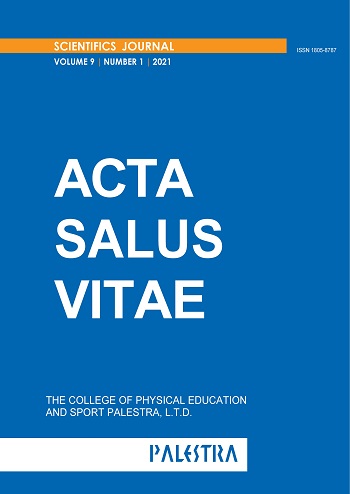Moral development in teaching aikido to children aged 6-16 years
DOI:
https://doi.org/10.58743/asv2021vol9no1.247Keywords:
Aikido; ethics; moral development; personal and social education.Abstract
The objective of the presented study was to prove the suitability of the martial art of aikido, as means of personal and social education for the formation of moral and ethical values and attitudes of an individual at school age. The research was conducted on a sample of disciples aged 8-15 years from the school of martial arts “Ronin Dojo”. Diagnostic methods: for one month, observations were made on Mondays, Wednesdays and Fridays to monitor participant's activities and behavior towards the authority of the instructor and among themselves. After the period of observation, the self - designed questionnaire, divided in two parts: „Questionnaire for children“, and „Questionnaire for parents“, was applied. Statistical analysis was performed in a qualitative manner, based on frequency analysis. The results elucidates the benefit of aikido to the creation of moral and ethical values and attitudes in the participants. By comparing the results of observation of an influence of the martial art aikido on the children who engage in the activity and their parents, i.e. those who in most cases led them to this activity, we point out the importance of both of these views and their interconnectedness. At the same time, the results demonstrate the connection and harmony of the club's cooperation with the family and thus a positive impact on children's development. The synergistic effect, which is evident from the cooperation, has a much greater positive benefit on the child than its individual components, i.e. than the very influence of the family or the very influence of the club.
References
Heidbrink, H. (1997). Psychologie morálního vývoje. [Psychology of moral development] Portál.
Kraus, B. (2008). Základy sociální pedagogiky. [Foundations of social pedagogy] Portál.
Kornatovská, Z., Moučková, P. (2020). Ethicotherapy and health education. Acta Salus Vitae, 8, 2: 47-55.
Krejčí, M. (2013). Self-transformation process in wellness and health education. Procedia Social and Behavioral Sciences. 3 (2):706–718. https://doi.org/10.1016/j.sbspro.2013.12.272.
Seaward, B. L. (2003). Health and wellness: Journal Workbook. 2. USA: Jones and Bartlett Publishers.
Rehor, P., Kornatovská, Z. (2013). Measuring of health - related benefits of physical activity in high school students. Acta Salus Vitae, 1 (2). 151 - 160.
Soják, P. (2017). Osobnostní a sociální rozvoj, aneb, strom, mozaika a vzducholoď. [Personal and social development, or, the tree, mosaic and airship] Grada.
Stevens, John. (2001). Tajemství aikido. [Secret of aikido] Fighters Publications.
Ueshiba, M., Stevens, J. (2016). Umění míru. [Art of the peace] B4U Publishing.
Vertonghen, J., Theeboom, M. (2010). The social-psychological outcomes of martial arts practice among youth: A review. Journal of Sports Science and Medicine, 9(4): 528–537. Available from: https://www.jssm.org/volume09/iss4/cap/jssm-09-528.pdf
Westbrook, A., Ratti, O. (2020). Aikido and the dynamic sphere: An illustrated introduction [online]. Vermont: Tuttle Publishing. [cit. 2020-10-19] ISBN 9781462907540. Available from: https://www.pdfdrive.com/aikido-and-the-dynamic-sphere-an-illustrated-introduction-e159327652.html
WHO (2000). The world health report 2000. Health Systems: Improving Performance. WHO: Geneva. - http://www.who.int/healthpromotion/about/HPRGlossary_NewTerms.pdf.
Downloads
Published
How to Cite
Issue
Section
License
Copyright (c) 2021 Martin Snopek

This work is licensed under a Creative Commons Attribution 4.0 International License.
Authors publishing in this journal agree to the following terms:
Authors retain copyright and grant the journal the right of first publication, while the work is also licensed under the Creative Commons Attribution License, which allows others to share this work acknowledging its author and initial publication in this journal.
Authors are permitted to enter into separate, additional contractual arrangements for the non-exclusive distribution of the work in the version published in the journal (for example, to publish it in a book), with an acknowledgement of its initial publication in this journal.
Authors are allowed and encouraged to share their work online (for example, on their websites) before and during the editorial process of their contribution, as such a practice can lead to productive exchanges of ideas and also earlier and higher citation of the published work (See the Open Access Effect).


